warning light NISSAN ROGUE SPORT 2017 Owners Manual
[x] Cancel search | Manufacturer: NISSAN, Model Year: 2017, Model line: ROGUE SPORT, Model: NISSAN ROGUE SPORT 2017Pages: 512, PDF Size: 3.33 MB
Page 10 of 512
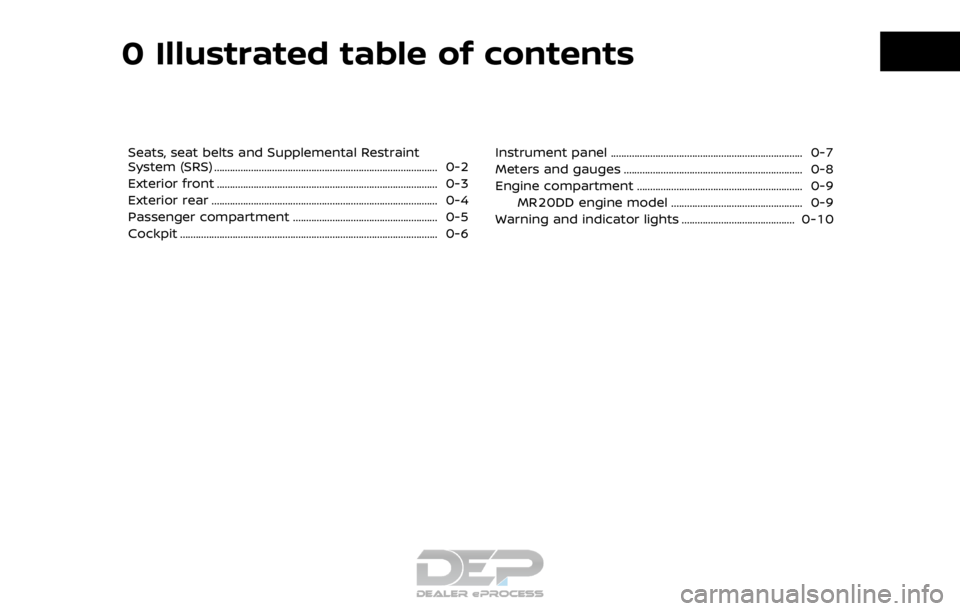
0 Illustrated table of contents
Seats, seat belts and Supplemental Restraint
System (SRS) ........................................................................\
............. 0-2
Exterior front ........................................................................\
............ 0-3
Exterior rear ........................................................................\
.............. 0-4
Passenger compartment ....................................................... 0-5
Cockpit ........................................................................\
.......................... 0-6Instrument panel ........................................................................\
. 0-7
Meters and gauges .................................................................... 0-8
Engine compartment ............................................................... 0-9
MR20DD engine model .................................................. 0-9
Warning and indicator lights ........................................... 0-10
Page 15 of 512
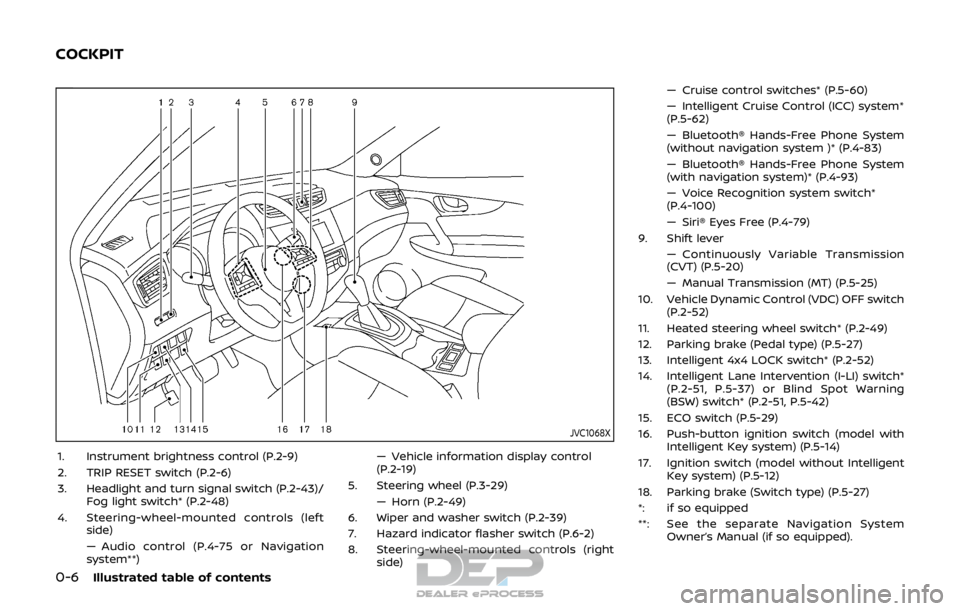
0-6Illustrated table of contents
JVC1068X
1. Instrument brightness control (P.2-9)
2. TRIP RESET switch (P.2-6)
3. Headlight and turn signal switch (P.2-43)/Fog light switch* (P.2-48)
4. Steering-wheel-mounted controls (left side)
— Audio control (P.4-75 or Navigation
system**) — Vehicle information display control
(P.2-19)
5. Steering wheel (P.3-29) — Horn (P.2-49)
6. Wiper and washer switch (P.2-39)
7. Hazard indicator flasher switch (P.6-2)
8. Steering-wheel-mounted controls (right side) — Cruise control switches* (P.5-60)
— Intelligent Cruise Control (ICC) system*
(P.5-62)
— Bluetooth® Hands-Free Phone System
(without navigation system )* (P.4-83)
— Bluetooth® Hands-Free Phone System
(with navigation system)* (P.4-93)
— Voice Recognition system switch*
(P.4-100)
— Siri® Eyes Free (P.4-79)
9. Shift lever — Continuously Variable Transmission
(CVT) (P.5-20)
— Manual Transmission (MT) (P.5-25)
10. Vehicle Dynamic Control (VDC) OFF switch (P.2-52)
11. Heated steering wheel switch* (P.2-49)
12. Parking brake (Pedal type) (P.5-27)
13. Intelligent 4x4 LOCK switch* (P.2-52)
14. Intelligent Lane Intervention (I-LI) switch* (P.2-51, P.5-37) or Blind Spot Warning
(BSW) switch* (P.2-51, P.5-42)
15. ECO switch (P.5-29)
16. Push-button ignition switch (model with Intelligent Key system) (P.5-14)
17. Ignition switch (model without Intelligent Key system) (P.5-12)
18. Parking brake (Switch type) (P.5-27)
*: if so equipped
**: See the separate Navigation System Owner’s Manual (if so equipped).
COCKPIT
Page 17 of 512
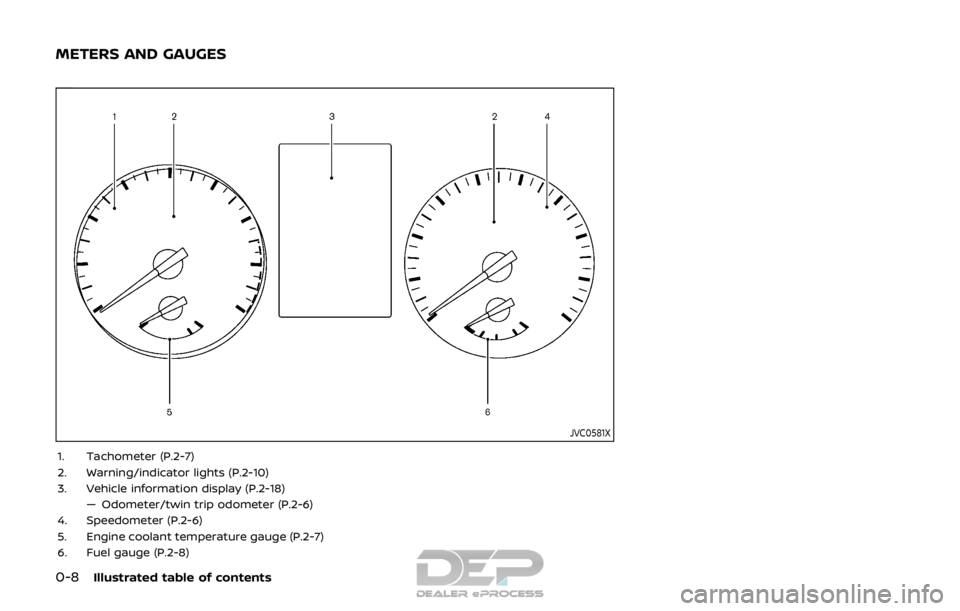
0-8Illustrated table of contents
JVC0581X
1. Tachometer (P.2-7)
2. Warning/indicator lights (P.2-10)
3. Vehicle information display (P.2-18)— Odometer/twin trip odometer (P.2-6)
4. Speedometer (P.2-6)
5. Engine coolant temperature gauge (P.2-7)
6. Fuel gauge (P.2-8)
METERS AND GAUGES
Page 19 of 512
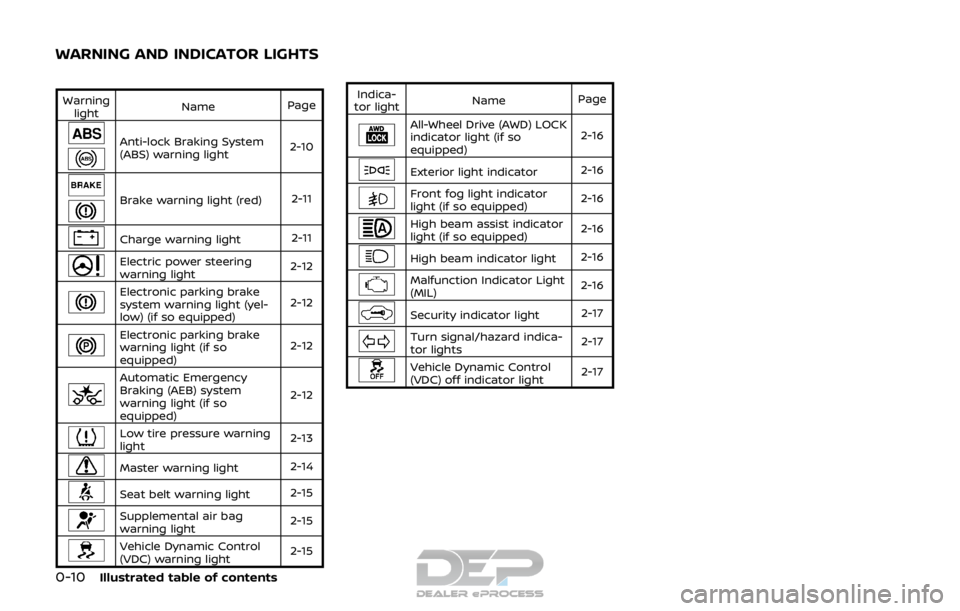
0-10Illustrated table of contents
Warninglight Name
Page
Anti-lock Braking System
(ABS) warning light 2-10
Brake warning light (red)
2-11
Charge warning light2-11
Electric power steering
warning light2-12
Electronic parking brake
system warning light (yel-
low) (if so equipped)2-12
Electronic parking brake
warning light (if so
equipped)2-12
Automatic Emergency
Braking (AEB) system
warning light (if so
equipped)2-12
Low tire pressure warning
light
2-13
Master warning light
2-14
Seat belt warning light 2-15
Supplemental air bag
warning light2-15
Vehicle Dynamic Control
(VDC) warning light2-15Indica-
tor light Name
Page
All-Wheel Drive (AWD) LOCK
indicator light (if so
equipped) 2-16
Exterior light indicator
2-16
Front fog light indicator
light (if so equipped)2-16
High beam assist indicator
light (if so equipped)2-16
High beam indicator light
2-16
Malfunction Indicator Light
(MIL)2-16
Security indicator light
2-17
Turn signal/hazard indica-
tor lights2-17
Vehicle Dynamic Control
(VDC) off indicator light
2-17
WARNING AND INDICATOR LIGHTS
Page 20 of 512
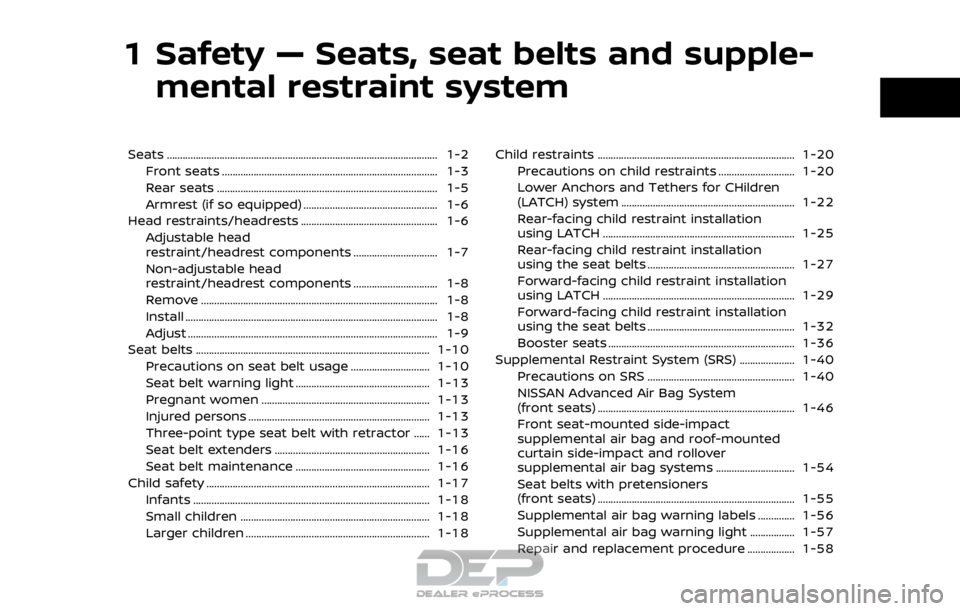
1 Safety — Seats, seat belts and supple-mental restraint system
Seats ........................................................................\
............................... 1-2
Front seats ........................................................................\
.......... 1-3
Rear seats ........................................................................\
............ 1-5
Armrest (if so equipped) ................................................... 1-6
Head restraints/headrests .................................................... 1-6 Adjustable head
restraint/headrest components ................................ 1-7
Non-adjustable head
restraint/headrest components ................................ 1-8
Remove ........................................................................\
.................. 1-8
Install ........................................................................\
........................ 1-8
Adjust ........................................................................\
....................... 1-9
Seat belts ........................................................................\
................. 1-10
Precautions on seat belt usage .............................. 1-10
Seat belt warning light ................................................... 1-13
Pregnant women ................................................................ 1-13
Injured persons ..................................................................... 1-13
Three-point type seat belt with retractor ...... 1-13
Seat belt extenders ........................................................... 1-16
Seat belt maintenance ................................................... 1-16
Child safety ........................................................................\
............. 1-17 Infants ........................................................................\
.................. 1-18
Small children ........................................................................\
1-18
Larger children ...................................................................... 1-18 Child restraints ........................................................................\
... 1-20
Precautions on child restraints ............................. 1-20
Lower Anchors and Tethers for CHildren
(LATCH) system .................................................................. 1-22
Rear-facing child restraint installation
using LATCH ........................................................................\
. 1-25
Rear-facing child restraint installation
using the seat belts ........................................................ 1-27
Forward-facing child restraint installation
using LATCH ........................................................................\
. 1-29
Forward-facing child restraint installation
using the seat belts ........................................................ 1-32
Booster seats ....................................................................... 1-36
Supplemental Restraint System (SRS) ..................... 1-40 Precautions on SRS ........................................................ 1-40
NISSAN Advanced Air Bag System
(front seats) ........................................................................\
... 1-46
Front seat-mounted side-impact
supplemental air bag and roof-mounted
curtain side-impact and rollover
supplemental air bag systems .............................. 1-54
Seat belts with pretensioners
(front seats) ........................................................................\
... 1-55
Supplemental air bag warning labels .............. 1-56
Supplemental air bag warning light ................. 1-57
Repair and replacement procedure .................. 1-58
Page 31 of 512
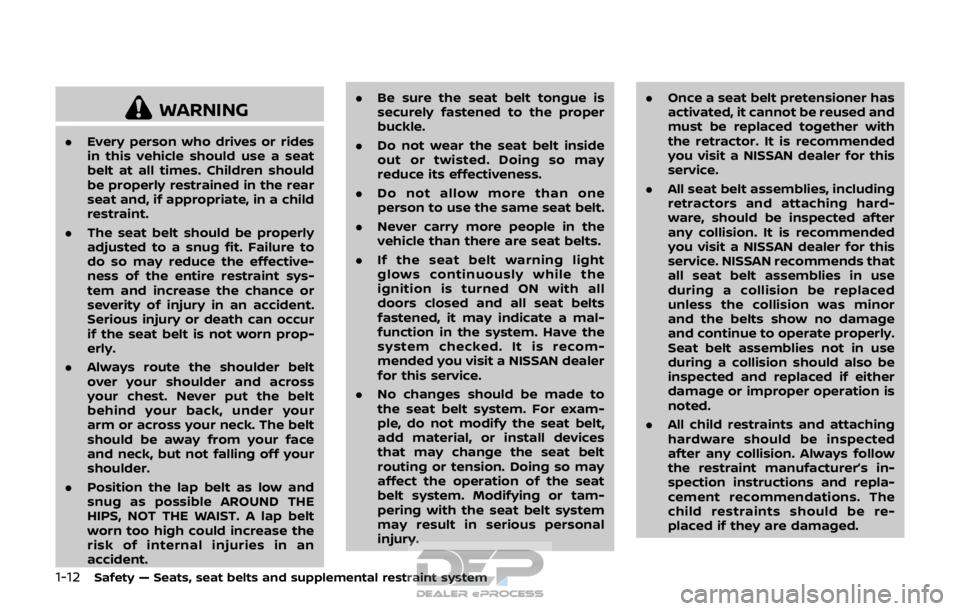
1-12Safety — Seats, seat belts and supplemental restraint system
WARNING
.Every person who drives or rides
in this vehicle should use a seat
belt at all times. Children should
be properly restrained in the rear
seat and, if appropriate, in a child
restraint.
. The seat belt should be properly
adjusted to a snug fit. Failure to
do so may reduce the effective-
ness of the entire restraint sys-
tem and increase the chance or
severity of injury in an accident.
Serious injury or death can occur
if the seat belt is not worn prop-
erly.
. Always route the shoulder belt
over your shoulder and across
your chest. Never put the belt
behind your back, under your
arm or across your neck. The belt
should be away from your face
and neck, but not falling off your
shoulder.
. Position the lap belt as low and
snug as possible AROUND THE
HIPS, NOT THE WAIST. A lap belt
worn too high could increase the
risk of internal injuries in an
accident. .
Be sure the seat belt tongue is
securely fastened to the proper
buckle.
. Do not wear the seat belt inside
out or twisted. Doing so may
reduce its effectiveness.
. Do not allow more than one
person to use the same seat belt.
. Never carry more people in the
vehicle than there are seat belts.
. If the seat belt warning light
glows continuously while the
ignition is turned ON with all
doors closed and all seat belts
fastened, it may indicate a mal-
function in the system. Have the
system checked. It is recom-
mended you visit a NISSAN dealer
for this service.
. No changes should be made to
the seat belt system. For exam-
ple, do not modify the seat belt,
add material, or install devices
that may change the seat belt
routing or tension. Doing so may
affect the operation of the seat
belt system. Modifying or tam-
pering with the seat belt system
may result in serious personal
injury. .
Once a seat belt pretensioner has
activated, it cannot be reused and
must be replaced together with
the retractor. It is recommended
you visit a NISSAN dealer for this
service.
. All seat belt assemblies, including
retractors and attaching hard-
ware, should be inspected after
any collision. It is recommended
you visit a NISSAN dealer for this
service. NISSAN recommends that
all seat belt assemblies in use
during a collision be replaced
unless the collision was minor
and the belts show no damage
and continue to operate properly.
Seat belt assemblies not in use
during a collision should also be
inspected and replaced if either
damage or improper operation is
noted.
. All child restraints and attaching
hardware should be inspected
after any collision. Always follow
the restraint manufacturer’s in-
spection instructions and repla-
cement recommendations. The
child restraints should be re-
placed if they are damaged.
Page 32 of 512
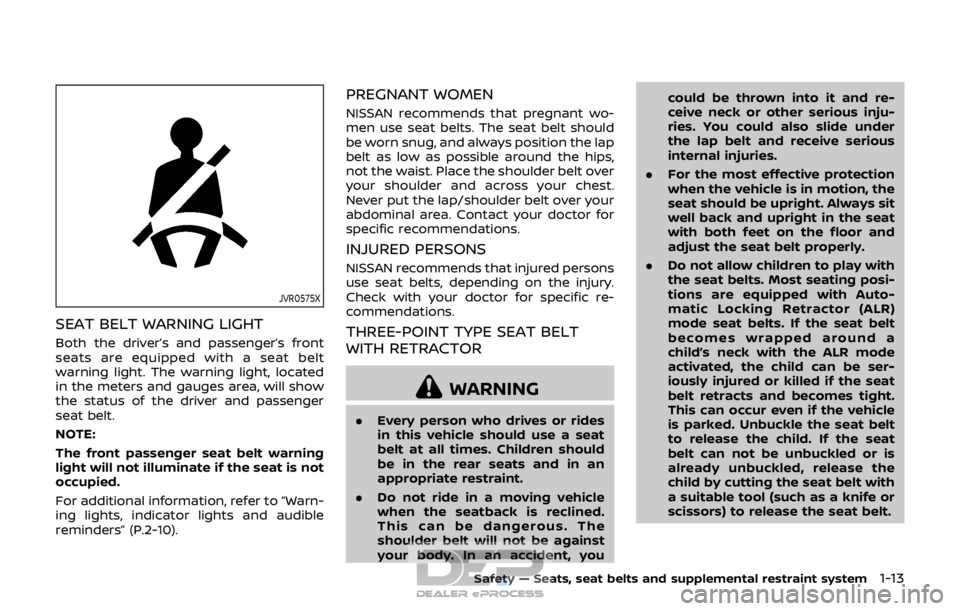
JVR0575X
SEAT BELT WARNING LIGHT
Both the driver’s and passenger’s front
seats are equipped with a seat belt
warning light. The warning light, located
in the meters and gauges area, will show
the status of the driver and passenger
seat belt.
NOTE:
The front passenger seat belt warning
light will not illuminate if the seat is not
occupied.
For additional information, refer to “Warn-
ing lights, indicator lights and audible
reminders” (P.2-10).
PREGNANT WOMEN
NISSAN recommends that pregnant wo-
men use seat belts. The seat belt should
be worn snug, and always position the lap
belt as low as possible around the hips,
not the waist. Place the shoulder belt over
your shoulder and across your chest.
Never put the lap/shoulder belt over your
abdominal area. Contact your doctor for
specific recommendations.
INJURED PERSONS
NISSAN recommends that injured persons
use seat belts, depending on the injury.
Check with your doctor for specific re-
commendations.
THREE-POINT TYPE SEAT BELT
WITH RETRACTOR
WARNING
.Every person who drives or rides
in this vehicle should use a seat
belt at all times. Children should
be in the rear seats and in an
appropriate restraint.
. Do not ride in a moving vehicle
when the seatback is reclined.
This can be dangerous. The
shoulder belt will not be against
your body. In an accident, you could be thrown into it and re-
ceive neck or other serious inju-
ries. You could also slide under
the lap belt and receive serious
internal injuries.
. For the most effective protection
when the vehicle is in motion, the
seat should be upright. Always sit
well back and upright in the seat
with both feet on the floor and
adjust the seat belt properly.
. Do not allow children to play with
the seat belts. Most seating posi-
tions are equipped with Auto-
matic Locking Retractor (ALR)
mode seat belts. If the seat belt
becomes wrapped around a
child’s neck with the ALR mode
activated, the child can be ser-
iously injured or killed if the seat
belt retracts and becomes tight.
This can occur even if the vehicle
is parked. Unbuckle the seat belt
to release the child. If the seat
belt can not be unbuckled or is
already unbuckled, release the
child by cutting the seat belt with
a suitable tool (such as a knife or
scissors) to release the seat belt.
Safety — Seats, seat belts and supplemental restraint system1-13
Page 51 of 512
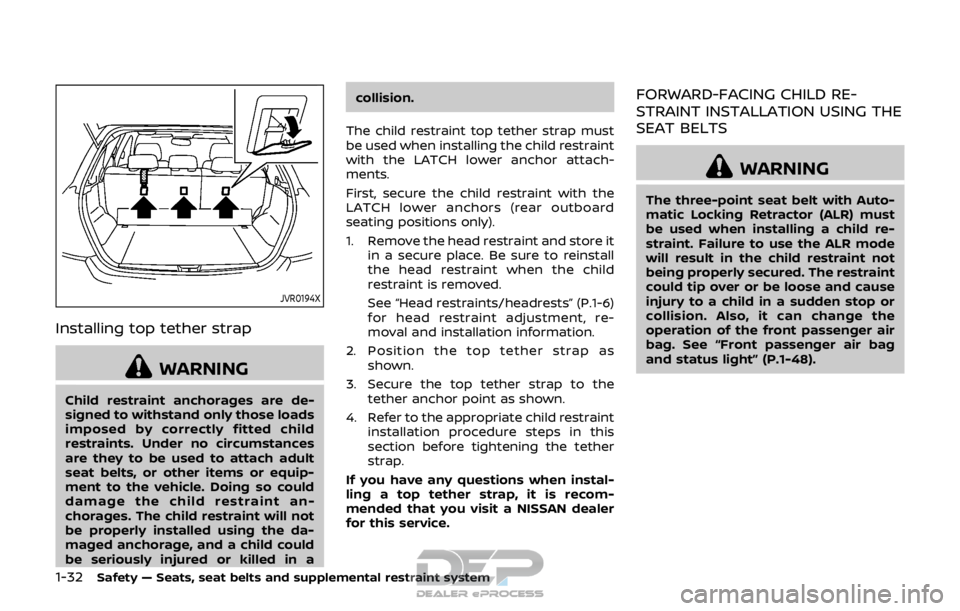
1-32Safety — Seats, seat belts and supplemental restraint system
JVR0194X
Installing top tether strap
WARNING
Child restraint anchorages are de-
signed to withstand only those loads
imposed by correctly fitted child
restraints. Under no circumstances
are they to be used to attach adult
seat belts, or other items or equip-
ment to the vehicle. Doing so could
damage the child restraint an-
chorages. The child restraint will not
be properly installed using the da-
maged anchorage, and a child could
be seriously injured or killed in acollision.
The child restraint top tether strap must
be used when installing the child restraint
with the LATCH lower anchor attach-
ments.
First, secure the child restraint with the
LATCH lower anchors (rear outboard
seating positions only).
1. Remove the head restraint and store it in a secure place. Be sure to reinstall
the head restraint when the child
restraint is removed.
See “Head restraints/headrests” (P.1-6)
for head restraint adjustment, re-
moval and installation information.
2. Position the top tether strap as shown.
3. Secure the top tether strap to the tether anchor point as shown.
4. Refer to the appropriate child restraint installation procedure steps in this
section before tightening the tether
strap.
If you have any questions when instal-
ling a top tether strap, it is recom-
mended that you visit a NISSAN dealer
for this service.
FORWARD-FACING CHILD RE-
STRAINT INSTALLATION USING THE
SEAT BELTS
WARNING
The three-point seat belt with Auto-
matic Locking Retractor (ALR) must
be used when installing a child re-
straint. Failure to use the ALR mode
will result in the child restraint not
being properly secured. The restraint
could tip over or be loose and cause
injury to a child in a sudden stop or
collision. Also, it can change the
operation of the front passenger air
bag. See “Front passenger air bag
and status light” (P.1-48).
Page 58 of 512
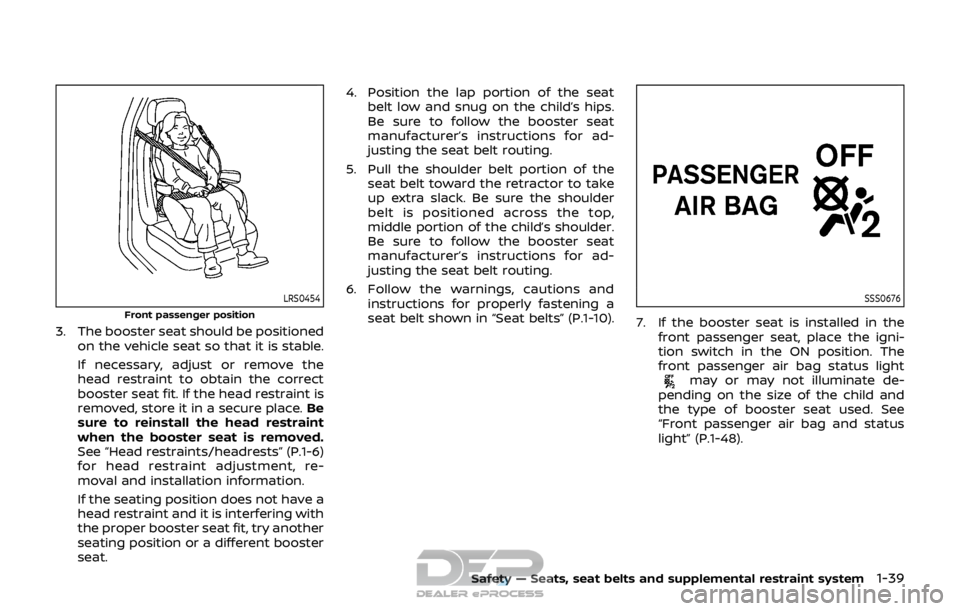
LRS0454
Front passenger position
3. The booster seat should be positionedon the vehicle seat so that it is stable.
If necessary, adjust or remove the
head restraint to obtain the correct
booster seat fit. If the head restraint is
removed, store it in a secure place. Be
sure to reinstall the head restraint
when the booster seat is removed.
See “Head restraints/headrests” (P.1-6)
for head restraint adjustment, re-
moval and installation information.
If the seating position does not have a
head restraint and it is interfering with
the proper booster seat fit, try another
seating position or a different booster
seat. 4. Position the lap portion of the seat
belt low and snug on the child’s hips.
Be sure to follow the booster seat
manufacturer’s instructions for ad-
justing the seat belt routing.
5. Pull the shoulder belt portion of the seat belt toward the retractor to take
up extra slack. Be sure the shoulder
belt is positioned across the top,
middle portion of the child’s shoulder.
Be sure to follow the booster seat
manufacturer’s instructions for ad-
justing the seat belt routing.
6. Follow the warnings, cautions and instructions for properly fastening a
seat belt shown in “Seat belts” (P.1-10).
SSS0676
7. If the booster seat is installed in thefront passenger seat, place the igni-
tion switch in the ON position. The
front passenger air bag status light
may or may not illuminate de-
pending on the size of the child and
the type of booster seat used. See
“Front passenger air bag and status
light” (P.1-48).
Safety — Seats, seat belts and supplemental restraint system1-39
Page 59 of 512
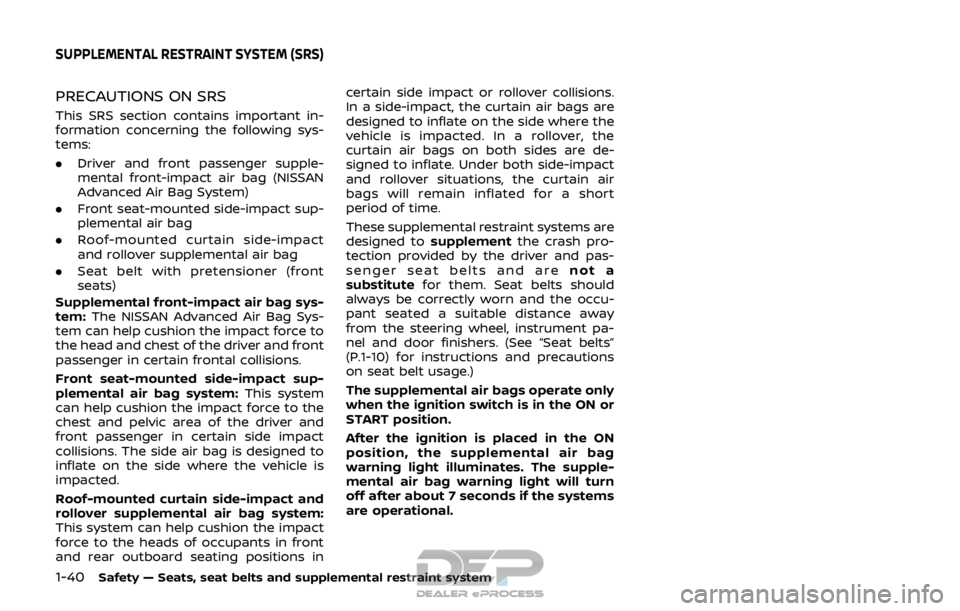
1-40Safety — Seats, seat belts and supplemental restraint system
PRECAUTIONS ON SRS
This SRS section contains important in-
formation concerning the following sys-
tems:
.Driver and front passenger supple-
mental front-impact air bag (NISSAN
Advanced Air Bag System)
. Front seat-mounted side-impact sup-
plemental air bag
. Roof-mounted curtain side-impact
and rollover supplemental air bag
. Seat belt with pretensioner (front
seats)
Supplemental front-impact air bag sys-
tem: The NISSAN Advanced Air Bag Sys-
tem can help cushion the impact force to
the head and chest of the driver and front
passenger in certain frontal collisions.
Front seat-mounted side-impact sup-
plemental air bag system: This system
can help cushion the impact force to the
chest and pelvic area of the driver and
front passenger in certain side impact
collisions. The side air bag is designed to
inflate on the side where the vehicle is
impacted.
Roof-mounted curtain side-impact and
rollover supplemental air bag system:
This system can help cushion the impact
force to the heads of occupants in front
and rear outboard seating positions in certain side impact or rollover collisions.
In a side-impact, the curtain air bags are
designed to inflate on the side where the
vehicle is impacted. In a rollover, the
curtain air bags on both sides are de-
signed to inflate. Under both side-impact
and rollover situations, the curtain air
bags will remain inflated for a short
period of time.
These supplemental restraint systems are
designed to
supplement the crash pro-
tection provided by the driver and pas-
senger seat belts and are not a
substitute for them. Seat belts should
always be correctly worn and the occu-
pant seated a suitable distance away
from the steering wheel, instrument pa-
nel and door finishers. (See “Seat belts”
(P.1-10) for instructions and precautions
on seat belt usage.)
The supplemental air bags operate only
when the ignition switch is in the ON or
START position.
After the ignition is placed in the ON
position, the supplemental air bag
warning light illuminates. The supple-
mental air bag warning light will turn
off after about 7 seconds if the systems
are operational.
SUPPLEMENTAL RESTRAINT SYSTEM (SRS)